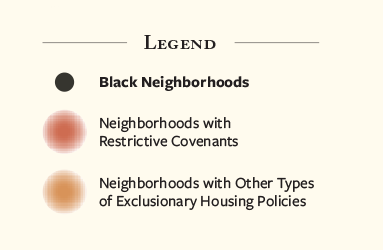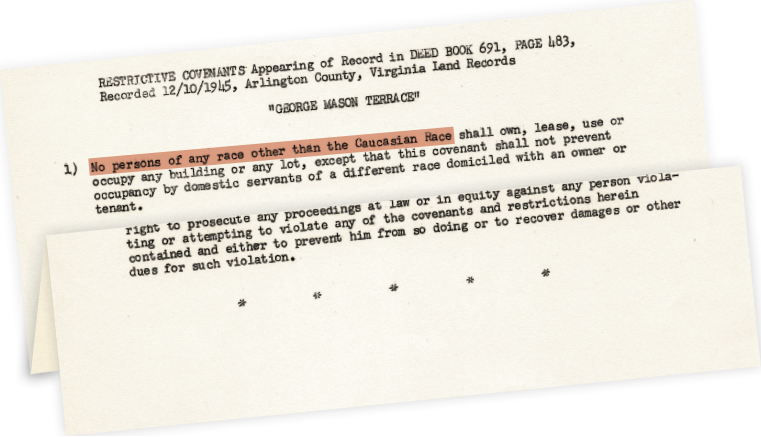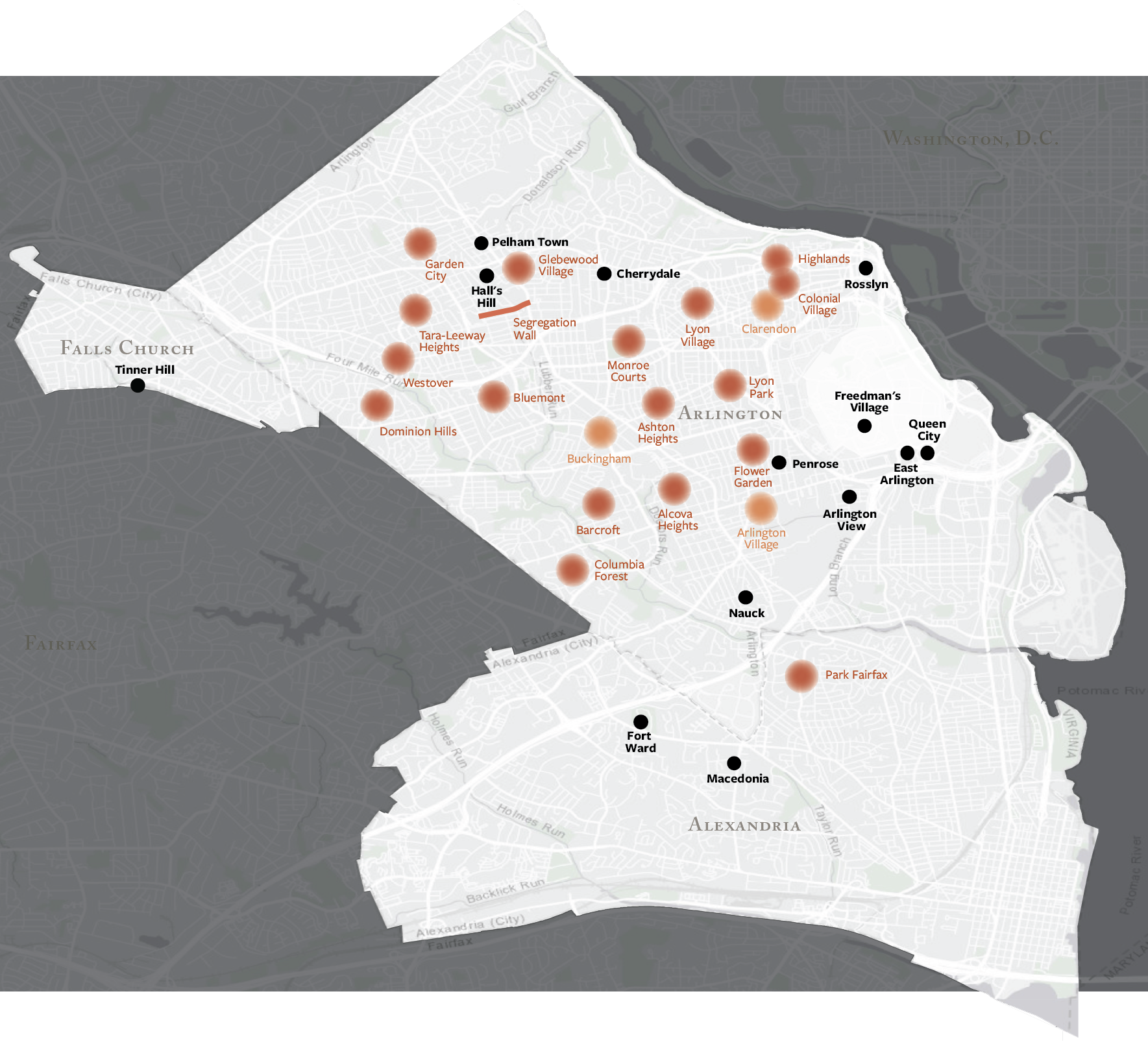Introduction
01
The Islands of Disadvantage
In 2019, the Center on Society and Health at Virginia Commonwealth University completed a series of studies (Getting Ahead and Measuring Opportunity) for the Northern Virginia Health Foundation that documented large geographic inequities in Northern Virginia. In a region known for its affluence, the Center documented a 17-year gap in life expectancy across census tracts and identified 15 “islands of disadvantage,” neighborhoods where residents, disproportionately people of color, face harsh living conditions.
These neighborhoods did not come into existence by accident. They are products of history. This website, commissioned by the Northern Virginia Health Foundation, is designed to share some of that history and show how policies adopted long ago concentrated wealth in a privileged population and blocked opportunities for others. Here we focus on the African American experience, but other people of color were also victims of violence and discrimination in Northern Virginia.

02
Colonialism
Today, Northern Virginia’s counties are among the wealthiest in the nation. Much of that affluence can be traced to the 1600s, when wealthy British landowners such as Thomas Culpeper, Thomas Fairfax, and Geroge Mason IV laid roots in the area. They built plantations, enslaved Black Africans, and accumulated wealth and power that they passed to their descendants. After the Civil War brought an end to enslavement, Black families in Northern Virginia continued to experience violence, discrimination, and Jim Crow policies that segregated them from safety and opportunity. Their access to education and income was restricted and they were less able than white people to build wealth and pass it to their descendants.
These barriers carried health consequences, then and today. Decades of research have shown that education, income, housing, and other social and community conditions are powerful determinants of life expectancy and disease rates. Access to health care is important, but health care accounts for only a small portion of health outcomes. Health behaviors matter greatly, but both health care and health behaviors are influenced by our environment and by the social and economic conditions in which we live.

02
Colonialism
Today, Northern Virginia’s counties are among the wealthiest in the nation. Much of that affluence can be traced to the 1600s, when wealthy British landowners such as Thomas Culpeper, Thomas Fairfax, and Geroge Mason IV laid roots in the area. They built plantations, enslaved Black Africans, and accumulated wealth and power that they passed to their descendants. After the Civil War brought an end to enslavement, Black families in Northern Virginia continued to experience violence, discrimination, and Jim Crow policies that segregated them from safety and opportunity. Their access to education and income was restricted and they were less able than white people to build wealth and pass it to their descendants.
These barriers carried health consequences, then and today. Decades of research have shown that education, income, housing, and other social and community conditions are powerful determinants of life expectancy and disease rates. Access to health care is important, but health care accounts for only a small portion of health outcomes. Health behaviors matter greatly, but both health care and health behaviors are influenced by our environment and by the social and economic conditions in which we live.
03
Policies of Exclusion
Today’s maps of health disparities have been shaped by social and economic conditions. They can be traced to policy decisions, made decades ago, that affected these determinants of health. Take housing, for example.
Today’s maps of food insecurity, poverty, and life expectancy can be overlaid with “redlining” maps from the 1930s. Redlining was the historic practice, now unconstitutional, of discouraging loans for homebuyers in red-shaded, majority Black and immigrant neighborhoods. Another discriminatory practice that was common in Northern Virginia was to include racially restrictive covenants in deeds for homes in “whites-only” neighborhoods, such as those in North Arlington and the Great Falls area, which barred sales to “non-Caucasians.” Many of these same areas retained their affluence and remain largely white today.
Blocking access to Housing and property is only one of many ways that opportunities for the Black community were systematically restricted in Northern Virginia. From colonial times until now, people of color have faced barriers to Education, Employment, Transportation, and Civil Rights. Click on the themes above to read stories, hear audio, and watch videos about the history of oppression and exclusion in each of these domains, but also visit the Resilience page to learn the inspiring stories of Black people, and their persistent efforts throughout history, to secure their rights and a better future for their children.



03
Policies of Exclusion
Today’s maps of health disparities have been shaped by social and economic conditions. They can be traced to policy decisions, made decades ago, that affected these determinants of health. Take housing, for example.
Today’s maps of food insecurity, poverty, and life expectancy can be overlaid with “redlining” maps from the 1930s. Redlining was the historic practice, now unconstitutional, of discouraging loans for homebuyers in red-shaded, majority Black and immigrant neighborhoods. Another discriminatory practice that was common in Northern Virginia was to include racially restrictive covenants in deeds for homes in “whites-only” neighborhoods, such as those in North Arlington and the Great Falls area, which barred sales to “non-Caucasians.” Many of these same areas retained their affluence and remain largely white today.
Blocking access to Housing and property is only one of many ways that opportunities for the Black community were systematically restricted in Northern Virginia. From colonial times until now, people of color have faced barriers to Education, Employment, Transportation, and Civil Rights. Click on the themes above to read stories, hear audio, and watch videos about the history of oppression and exclusion in each of these domains, but also visit the Resilience page to learn the inspiring stories of Black people, and their persistent efforts throughout history, to secure their rights and a better future for their children.



04
History for Tomorrow
Reminding ourselves of the past can improve our future. History reminds us that policies of the past literally drew the maps we see today. This means that today’s policies have the power to change our future. Visit our Resources page for reading materials not only about the history of Northern Virginia but also policy opportunities to advance equity in each of the domains we cover: housing, education, employment, transportation, and civil rights.



